高中英语听说课教案
- 格式:docx
- 大小:12.68 KB
- 文档页数:5
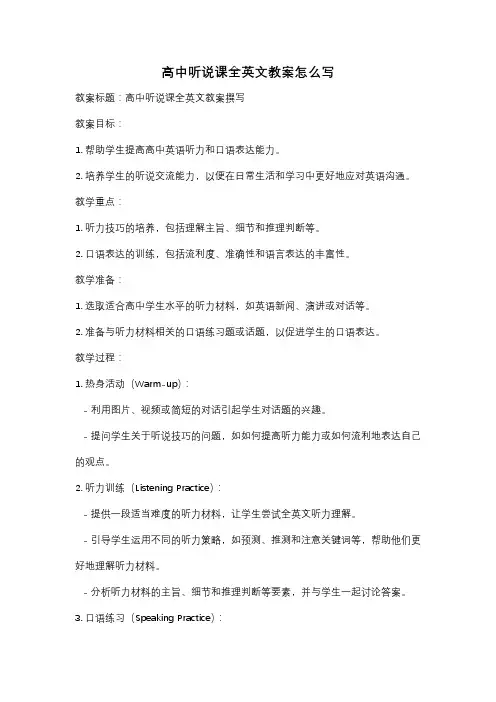
高中听说课全英文教案怎么写教案标题:高中听说课全英文教案撰写教案目标:1. 帮助学生提高高中英语听力和口语表达能力。
2. 培养学生的听说交流能力,以便在日常生活和学习中更好地应对英语沟通。
教学重点:1. 听力技巧的培养,包括理解主旨、细节和推理判断等。
2. 口语表达的训练,包括流利度、准确性和语言表达的丰富性。
教学准备:1. 选取适合高中学生水平的听力材料,如英语新闻、演讲或对话等。
2. 准备与听力材料相关的口语练习题或话题,以促进学生的口语表达。
教学过程:1. 热身活动(Warm-up):- 利用图片、视频或简短的对话引起学生对话题的兴趣。
- 提问学生关于听说技巧的问题,如如何提高听力能力或如何流利地表达自己的观点。
2. 听力训练(Listening Practice):- 提供一段适当难度的听力材料,让学生尝试全英文听力理解。
- 引导学生运用不同的听力策略,如预测、推测和注意关键词等,帮助他们更好地理解听力材料。
- 分析听力材料的主旨、细节和推理判断等要素,并与学生一起讨论答案。
3. 口语练习(Speaking Practice):- 提供与听力材料相关的口语练习题或话题,鼓励学生运用所学知识进行口语表达。
- 在小组或整体讨论的形式下,让学生分享自己的观点、经验或意见,并鼓励他们互相交流和提问。
- 提供语言表达的反馈和指导,帮助学生改进口语表达的准确性、流利度和语言表达的丰富性。
4. 结束活动(Wrap-up):- 总结本堂课的学习内容,强调学生在听说方面的进步和提高。
- 鼓励学生继续进行听说练习,并提供相关的学习资源或建议。
教学延伸:1. 鼓励学生在课后进行更多的听力练习,如听英语新闻、音乐或英语播客等。
2. 提供学生参与英语角或英语辩论等口语实践的机会,以提高他们的口语表达能力。
3. 推荐学生使用在线学习平台或语言学习应用程序,如BBC Learning English、Duolingo等,以增强他们的听说技能。
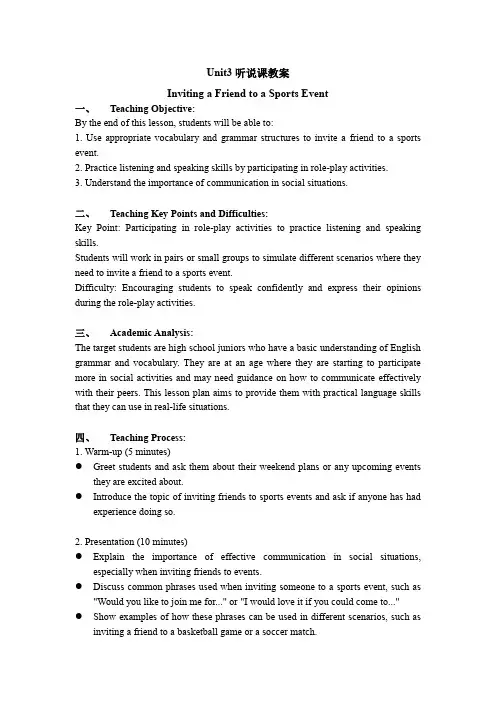
Unit3听说课教案Inviting a Friend to a Sports Event一、Teaching Objective:By the end of this lesson, students will be able to:1. Use appropriate vocabulary and grammar structures to invite a friend to a sports event.2. Practice listening and speaking skills by participating in role-play activities.3. Understand the importance of communication in social situations.二、Teaching Key Points and Difficulties:Key Point: Participating in role-play activities to practice listening and speaking skills.Students will work in pairs or small groups to simulate different scenarios where they need to invite a friend to a sports event.Difficulty: Encouraging students to speak confidently and express their opinions during the role-play activities.三、Academic Analysis:The target students are high school juniors who have a basic understanding of English grammar and vocabulary. They are at an age where they are starting to participate more in social activities and may need guidance on how to communicate effectively with their peers. This lesson plan aims to provide them with practical language skills that they can use in real-life situations.四、Teaching Process:1. Warm-up (5 minutes)●Greet students and ask them about their weekend plans or any upcoming eventsthey are excited about.●Introduce the topic of inviting friends to sports events and ask if anyone has hadexperience doing so.2. Presentation (10 minutes)●Explain the importance of effective communication in social situations,especially when inviting friends to events.●Discuss common phrases used when inviting someone to a sports event, such as"Would you like to join me for..." or "I would love it if you could come to..."●Show examples of how these phrases can be used in different scenarios, such asinviting a friend to a basketball game or a soccer match.3. Practice (15 minutes)●Divide students into pairs or small groups and give each group a set of scenariocards with different ways of inviting a friend to a sports event.●Ask students to role-play the scenarios using the phrases they learned in thepresentation, making sure to encourage them to speak confidently and express their opinions.●After each pair or group has finished their role-play, ask for feedback from therest of the class on their performance and offer suggestions for improvement.4. Production (10 minutes)●Have one student from each pair or group present their role-play to the class,focusing on their use of language and expressions learned in the lesson.●Assess their performance based on factors such as pronunciation, grammaraccuracy, and confidence in speaking.5. Consolidation (5 minutes)●Review the key points and difficulties of the lesson, encouraging students toreflect on what they learned and how they can apply it in their daily lives.●Encourage students to continue practicing their English skills outside of class byinviting friends to other events, such as movie nights or dinner dates.。
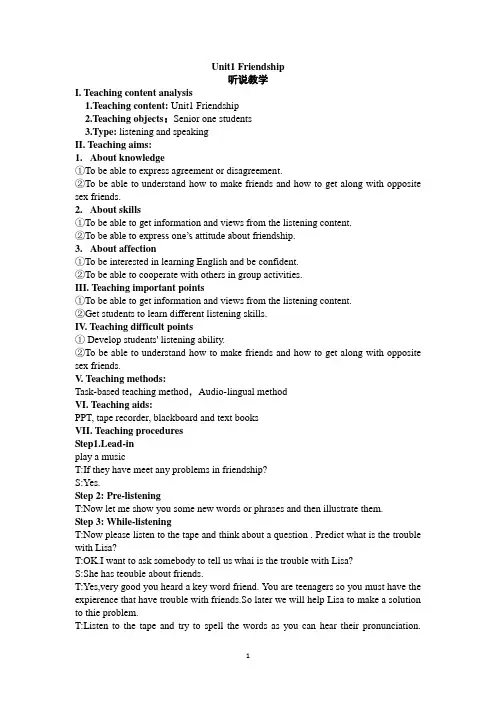
Unit1 Friendship听说教学I. Teaching content analysis1.Teaching content: Unit1 Friendship2.Teaching objects:Senior one students3.Type: listening and speakingII. Teaching aims:1.About knowledge①To be able to express agreement or disagreement.②To be able to understand how to make friends and how to get along with opposite sex friends.2.About skills①To be able to get information and views from the listening content.②To be able to express one’s attitude about friendship.3.About affection①To be interested in learning English and be confident.②To be able to cooperate with others in group activities.III. Teaching important points①To be able to get information and views from the listening content.②Get students to learn different listening skills.IV. Teaching difficult points① Develop students' listening ability.②To be able to understand how to make friends and how to get along with opposite sex friends.V. Teaching methods:Task-based teaching method,Audio-lingual methodVI. Teaching aids:PPT, tape recorder, blackboard and text booksVII. Teaching proceduresStep1.Lead-inplay a musicT:If they have meet any problems in friendship?S:Yes.Step 2: Pre-listeningT:Now let me show you some new words or phrases and then illustrate them.Step 3: While-listeningT:Now please listen to the tape and think about a question . Predict what is the trouble with Lisa?T:OK.I want to ask somebody to tell us whai is the trouble with Lisa?S:She has teouble about friends.T:Yes,very good you heard a key word friend. You are teenagers so you must have the expierence that have trouble with friends.So later we will help Lisa to make a solution to thie problem.T:Listen to the tape and try to spell the words as you can hear their pronunciation.Then write your answers about the blank place on the paper. (on PPT).(After the first listening)S:(Answer the questions.)T:OK, stop. Let’s share the answers. Well done.T:Now, please Listen to the tape again and use the exercise above to help you answer the following questions (on PPT).1.What does Miss Wang say about their friendship?She says that__________________________________________2.Why doesn’t she think that Lisa should end their friendship?She thinks that __________________________________________3.How does she e xplain why Lisa’s classmates gossip about their friendship?She says that __________________________________________4.What is Miss Wang’s advice?She asks Lisa to __________________________________________S:(Answer the questions.)(After the second listening)T:Now let us listen again with seeing the text on PPT,OK? Please pay attention to the details and the character.(After the third listening)T:OK, now you can see the text clearly and we’ve already known the details.Step 4: Post-listeningT:Now let me show you some new words ,phrases and sentences which may be used T:OK. I will ask some students to work in pair and role-play, and discuss the following questions.(on PPT)T:Group1.please stand up!T:Do you think that it is a good idea for Lisa to keep silent about the gossip?S:Yes, because...T:Now let us have a competition. Look at the PPT. And i will divide you into 8 groups and then you should consider the questions on the PPT.T :Well done! Some of you are good at speech and discussion! So today is enouggh ,I hope you can be better next time !Step5.SummaryTell students the tips of listening tasks.Ask two students to summary this lesson and talk about their feelings.Step 6.Homework1.Finish the exercise in the exercise book.2.Talk about your experience in your lifeVII. The layout of the blackboard。
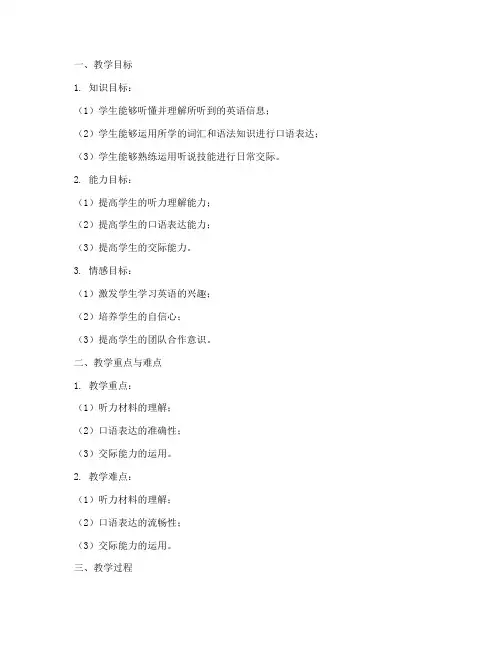
一、教学目标1. 知识目标:(1)学生能够听懂并理解所听到的英语信息;(2)学生能够运用所学的词汇和语法知识进行口语表达;(3)学生能够熟练运用听说技能进行日常交际。
2. 能力目标:(1)提高学生的听力理解能力;(2)提高学生的口语表达能力;(3)提高学生的交际能力。
3. 情感目标:(1)激发学生学习英语的兴趣;(2)培养学生的自信心;(3)提高学生的团队合作意识。
二、教学重点与难点1. 教学重点:(1)听力材料的理解;(2)口语表达的准确性;(3)交际能力的运用。
2. 教学难点:(1)听力材料的理解;(2)口语表达的流畅性;(3)交际能力的运用。
三、教学过程1. 导入(1)利用多媒体展示与教学内容相关的图片、视频等,激发学生的学习兴趣;(2)通过简短的英语对话,引导学生复习所学词汇和语法知识。
2. 听力训练(1)播放听力材料,要求学生认真听并回答相关问题;(2)针对听力材料中的重点词汇和语法,进行讲解和练习;(3)组织学生进行小组讨论,分享听力过程中的感受和收获。
3. 口语表达(1)根据听力材料,引导学生进行口语表达练习;(2)教师针对学生的口语表达进行点评和指导;(3)组织学生进行角色扮演,提高口语表达能力。
4. 交际活动(1)设计与教学内容相关的交际活动,如:小组讨论、辩论、角色扮演等;(2)鼓励学生积极参与交际活动,提高交际能力;(3)教师针对交际活动进行点评和总结。
5. 课堂小结(1)回顾本节课所学的知识点;(2)强调听力、口语和交际能力的重要性;(3)布置课后作业,巩固所学知识。
四、教学评价1. 课堂表现:观察学生在课堂上的参与度、口语表达能力、交际能力等;2. 课后作业:检查学生的作业完成情况,了解学生的学习效果;3. 听力测试:通过听力测试,评估学生的听力理解能力;4. 口语测试:通过口语测试,评估学生的口语表达能力。
五、教学反思1. 教学过程中,关注学生的个体差异,因材施教;2. 创设丰富的教学情境,激发学生的学习兴趣;3. 注重培养学生的听说能力和交际能力;4. 及时总结教学经验,不断改进教学方法。
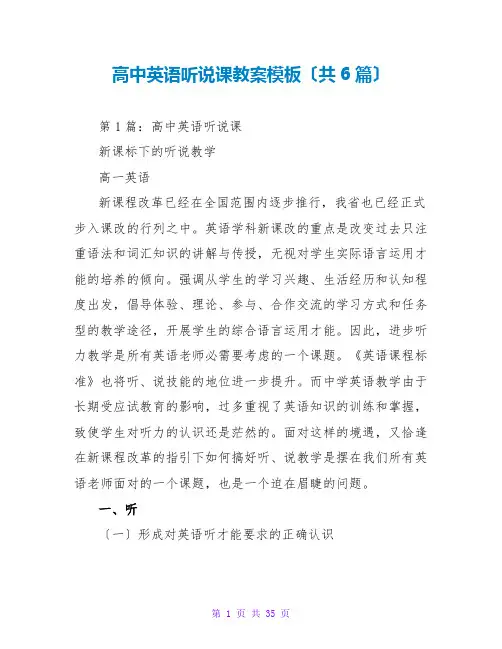
高中英语听说课教案模板〔共6篇〕第1篇:高中英语听说课新课标下的听说教学高一英语新课程改革已经在全国范围内逐步推行,我省也已经正式步入课改的行列之中。
英语学科新课改的重点是改变过去只注重语法和词汇知识的讲解与传授,无视对学生实际语言运用才能的培养的倾向。
强调从学生的学习兴趣、生活经历和认知程度出发,倡导体验、理论、参与、合作交流的学习方式和任务型的教学途径,开展学生的综合语言运用才能。
因此,进步听力教学是所有英语老师必需要考虑的一个课题。
《英语课程标准》也将听、说技能的地位进一步提升。
而中学英语教学由于长期受应试教育的影响,过多重视了英语知识的训练和掌握,致使学生对听力的认识还是茫然的。
面对这样的境遇,又恰逢在新课程改革的指引下如何搞好听、说教学是摆在我们所有英语老师面对的一个课题,也是一个迫在眉睫的问题。
一、听〔一〕形成对英语听才能要求的正确认识新课标逐年加大听力局部的分值。
目前,英语口试还不作一般考试的要求,所以,学生不会创造气氛去说英语。
基于这种情况,我们应努力让学生理解,好的听力不仅对笔试有帮助,它更是一种才能的表达,因为我们学英语的目的不是为了考试,考试是作为一种催促的手段,我们的目的是用英语来进展交际。
口头交流是最简单最普遍的交际方式。
而只有我们在听得懂别人说的话和说得出自己的观点时,我们才有交流。
所以说,听懂说好英语既是我们学习的目的,也是学习英语的根本要求。
〔二〕听前准备听前的准备工作是非常重要的,一般情况下老师只是留几分钟时间让学生自己看要答复的问题,或在多媒体课件上列出一些听力内容中的生词、词组后就让学生听了。
听完后直接对答案。
但对于那些内容较难的听力材料,我们除了做以上工作外还应该给学生讲解一些关于听力材料的背景知识,把它当作听前的热身。
可以先让学生们看问题和与它相对应的选项,在他们看完以后,我让他们猜想听力材料的大致内容。
多数同学猜不出来,少数能猜出来的同学也不敢答复。
这时可以在黑板上列出了以下一些【关键词】:^p 。
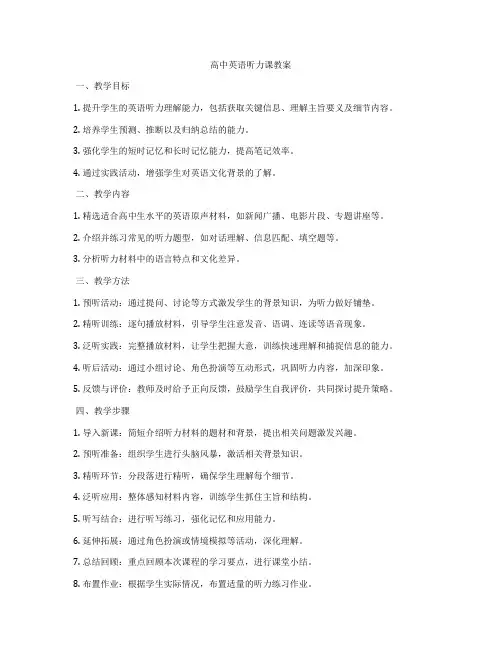
高中英语听力课教案一、教学目标1. 提升学生的英语听力理解能力,包括获取关键信息、理解主旨要义及细节内容。
2. 培养学生预测、推断以及归纳总结的能力。
3. 强化学生的短时记忆和长时记忆能力,提高笔记效率。
4. 通过实践活动,增强学生对英语文化背景的了解。
二、教学内容1. 精选适合高中生水平的英语原声材料,如新闻广播、电影片段、专题讲座等。
2. 介绍并练习常见的听力题型,如对话理解、信息匹配、填空题等。
3. 分析听力材料中的语言特点和文化差异。
三、教学方法1. 预听活动:通过提问、讨论等方式激发学生的背景知识,为听力做好铺垫。
2. 精听训练:逐句播放材料,引导学生注意发音、语调、连读等语音现象。
3. 泛听实践:完整播放材料,让学生把握大意,训练快速理解和捕捉信息的能力。
4. 听后活动:通过小组讨论、角色扮演等互动形式,巩固听力内容,加深印象。
5. 反馈与评价:教师及时给予正向反馈,鼓励学生自我评价,共同探讨提升策略。
四、教学步骤1. 导入新课:简短介绍听力材料的题材和背景,提出相关问题激发兴趣。
2. 预听准备:组织学生进行头脑风暴,激活相关背景知识。
3. 精听环节:分段落进行精听,确保学生理解每个细节。
4. 泛听应用:整体感知材料内容,训练学生抓住主旨和结构。
5. 听写结合:进行听写练习,强化记忆和应用能力。
6. 延伸拓展:通过角色扮演或情境模拟等活动,深化理解。
7. 总结回顾:重点回顾本次课程的学习要点,进行课堂小结。
8. 布置作业:根据学生实际情况,布置适量的听力练习作业。
五、教学资源1. 音频播放器或电脑多媒体设备。
2. 英语听力教材和配套练习册。
3. 互联网资源,如在线听力练习网站、英语学习A等。
六、评价方式1. 平时成绩:包括课堂表现、作业完成情况和平时测验成绩。
2. 期末评估:通过模拟考试或者实际听力测试来综合评估学生的听力水平。
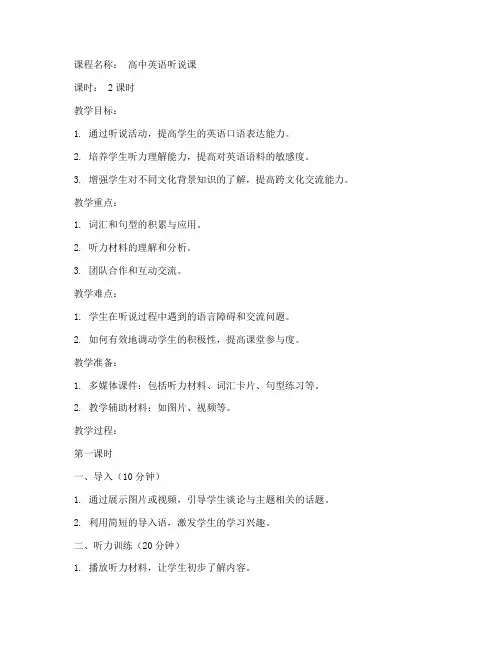
课程名称:高中英语听说课课时: 2课时教学目标:1. 通过听说活动,提高学生的英语口语表达能力。
2. 培养学生听力理解能力,提高对英语语料的敏感度。
3. 增强学生对不同文化背景知识的了解,提高跨文化交流能力。
教学重点:1. 词汇和句型的积累与应用。
2. 听力材料的理解和分析。
3. 团队合作和互动交流。
教学难点:1. 学生在听说过程中遇到的语言障碍和交流问题。
2. 如何有效地调动学生的积极性,提高课堂参与度。
教学准备:1. 多媒体课件:包括听力材料、词汇卡片、句型练习等。
2. 教学辅助材料:如图片、视频等。
教学过程:第一课时一、导入(10分钟)1. 通过展示图片或视频,引导学生谈论与主题相关的话题。
2. 利用简短的导入语,激发学生的学习兴趣。
二、听力训练(20分钟)1. 播放听力材料,让学生初步了解内容。
2. 引导学生听细节,回答问题。
3. 分组讨论,分享听力感受和观点。
三、词汇和句型练习(15分钟)1. 教师带领学生总结听力材料中的重点词汇和句型。
2. 学生进行小组练习,运用所学词汇和句型进行对话。
四、小组活动(20分钟)1. 学生分组,根据所学内容进行角色扮演。
2. 鼓励学生发挥创意,展示自己的英语口语能力。
五、总结(5分钟)1. 教师总结本节课的重点内容。
2. 学生分享学习心得,提出疑问。
第二课时一、复习(10分钟)1. 回顾上一节课的内容,检查学生的学习情况。
2. 学生进行口语练习,巩固所学知识。
二、听力训练(20分钟)1. 播放新的听力材料,提高学生的听力水平。
2. 学生完成听力练习,教师点评。
三、口语表达(15分钟)1. 学生根据所学内容,进行口语表达练习。
2. 教师给予指导和鼓励。
四、小组讨论(20分钟)1. 学生分组,就某一话题进行讨论。
2. 鼓励学生积极参与,发表自己的观点。
五、总结(5分钟)1. 教师总结本节课的重点内容。
2. 学生分享学习心得,提出疑问。
教学反思:1. 教师应关注学生的个体差异,因材施教。
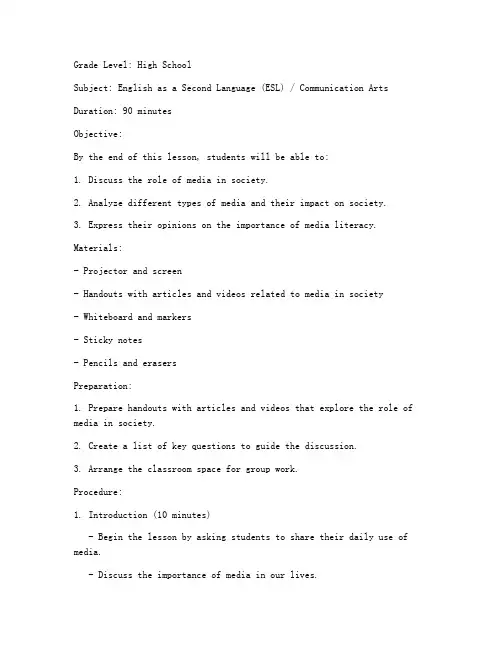
Grade Level: High SchoolSubject: English as a Second Language (ESL) / Communication ArtsDuration: 90 minutesObjective:By the end of this lesson, students will be able to:1. Discuss the role of media in society.2. Analyze different types of media and their impact on society.3. Express their opinions on the importance of media literacy.Materials:- Projector and screen- Handouts with articles and videos related to media in society- Whiteboard and markers- Sticky notes- Pencils and erasersPreparation:1. Prepare handouts with articles and videos that explore the role of media in society.2. Create a list of key questions to guide the discussion.3. Arrange the classroom space for group work.Procedure:1. Introduction (10 minutes)- Begin the lesson by asking students to share their daily use of media.- Discuss the importance of media in our lives.- Introduce the lesson objective: Understanding the Role of Media in Society.2. Presentation (15 minutes)- Present a short video or a series of images that highlight the various roles of media.- Discuss the different types of media: print, television, radio, internet, and social media.- Explain the concept of media literacy and its importance.3. Reading and Analysis (20 minutes)- Distribute handouts with articles related to media in society.- Instruct students to read the articles and take notes on key points.- Divide the class into small groups and assign each group adifferent article.- Ask each group to discuss the following questions:- What is the main message of the article?- How does the article define the role of media in society?- What are the positive and negative impacts of media on society?- Each group will report back to the class.4. Group Discussion (20 minutes)- Post several key questions on the whiteboard for the class to discuss:- How does media influence public opinion?- Can media be biased? If so, how?- What is the role of the media in promoting social change?- Assign each student a sticky note and ask them to write down their thoughts on one of the questions.- Have students place their sticky notes on the whiteboard, creating a visual representation of class opinions.5. Conclusion (10 minutes)- Summarize the key points discussed during the lesson.- Ask students to express their opinions on the importance of media literacy.- Encourage students to reflect on their own use of media and how they can become more media-literate.Assessment:- Participation in class discussions and group activities.- Completion of handouts with articles and notes.- Ability to express opinions on the importance of media literacy.Extension Activities:- Have students create their own media project (e.g., a blog post, a video, or a podcast) on a topic related to media in society.- Organize a debate on the topic of media bias and its impact on society.- Invite a guest speaker from the media industry to discuss the challenges and opportunities of working in the media field.Reflection:- At the end of the lesson, ask students to reflect on what they have learned and how they will apply this knowledge in their daily lives.。
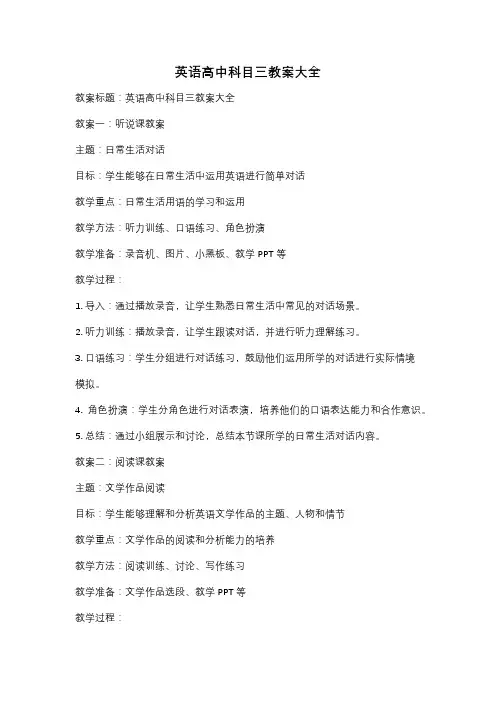
英语高中科目三教案大全教案标题:英语高中科目三教案大全教案一:听说课教案主题:日常生活对话目标:学生能够在日常生活中运用英语进行简单对话教学重点:日常生活用语的学习和运用教学方法:听力训练、口语练习、角色扮演教学准备:录音机、图片、小黑板、教学PPT等教学过程:1. 导入:通过播放录音,让学生熟悉日常生活中常见的对话场景。
2. 听力训练:播放录音,让学生跟读对话,并进行听力理解练习。
3. 口语练习:学生分组进行对话练习,鼓励他们运用所学的对话进行实际情境模拟。
4. 角色扮演:学生分角色进行对话表演,培养他们的口语表达能力和合作意识。
5. 总结:通过小组展示和讨论,总结本节课所学的日常生活对话内容。
教案二:阅读课教案主题:文学作品阅读目标:学生能够理解和分析英语文学作品的主题、人物和情节教学重点:文学作品的阅读和分析能力的培养教学方法:阅读训练、讨论、写作练习教学准备:文学作品选段、教学PPT等教学过程:1. 导入:通过展示一段文学作品的图片或引用一句名言,引起学生的兴趣。
2. 阅读训练:学生独立阅读文学作品选段,并回答相关问题,培养他们的阅读理解能力。
3. 讨论:学生分组讨论文学作品的主题、人物和情节,引导他们从多个角度进行分析。
4. 写作练习:学生根据所读的文学作品写一篇读后感或书评,培养他们的写作能力和批判思维。
5. 总结:通过学生的讨论和写作作品展示,总结本节课所学的文学作品阅读技巧和分析方法。
教案三:写作课教案主题:写作技巧训练目标:学生能够运用合适的写作技巧写作英语文章教学重点:写作技巧的学习和运用教学方法:写作训练、示范、评估教学准备:写作题目、教学PPT等教学过程:1. 导入:通过展示一篇优秀的英语文章或提出一个写作话题,激发学生的写作兴趣。
2. 写作训练:学生进行写作训练,根据提供的写作题目进行写作练习。
3. 示范:教师示范一篇范文,讲解写作技巧和注意事项。
4. 互评:学生互相交换作文,进行互评,提出改进建议。

高中英语听说课教案及反思一、教学目标1. 语言知识目标:(1)能够听懂、会说、会读、会写以下句子:He is a good student.He studies hard.(2)能够听懂、会说、会读、会写以下单词:Good, student, hard2. 情感态度价值观目标:通过本节课的学习,学生能够体会到学习的重要性,学会珍惜学习的机会,努力学习,取得更好的成绩。
二、教学重点1. 能够听懂、会说、会读、会写以下句子:He is a good student.He studies hard.2. 能够听懂、会说、会读、会写以下单词:Good, student, hard三、教学准备1. 教学用书:高中英语课本2. 教学器材:录音机、多媒体3. 教学过程(1)Warm-up1. Greeting2. Free talk(2)Lead-in1. Show some pictures about students studying hard.2. Ask students to talk about the pictures.(3)Pre-listening1. Ask students to look at the pictures and guess what the dialogue is about.2. Ask students to make a prediction about the dialogue.(4)While-listening1. Play the recording for students to listen.2. Ask students to listen and answer the questions.(5)Post-listening1. Ask students to discuss the dialogue in pairs.2. Ask students to summarize the dialogue.(6)Consolidation1. Ask students to practice the dialogue in pairs.2. Ask students to write a short passage about the dialogue.四、教学反思本节课的教学内容是高中英语听说课,我采用了多媒体辅助教学的方法,让学生在轻松愉快的氛围中学习,学生们也表现出了很大的积极性,他们都能够听懂、会说、会读、会写以下句子和单词,并且能够熟练的运用这些句子和单词,这让我感到很欣慰。
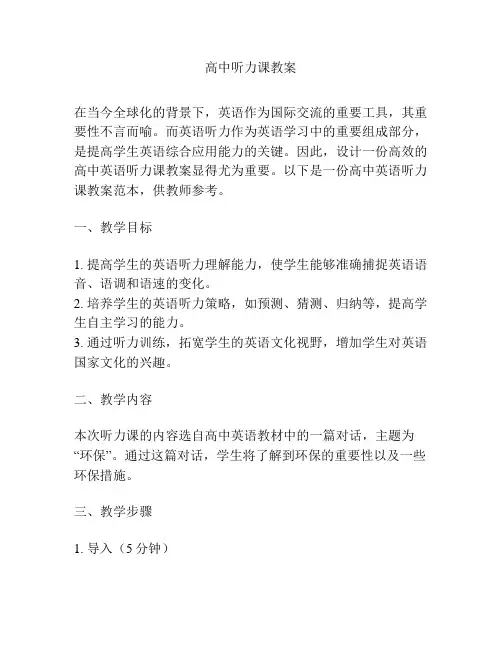
高中听力课教案在当今全球化的背景下,英语作为国际交流的重要工具,其重要性不言而喻。
而英语听力作为英语学习中的重要组成部分,是提高学生英语综合应用能力的关键。
因此,设计一份高效的高中英语听力课教案显得尤为重要。
以下是一份高中英语听力课教案范本,供教师参考。
一、教学目标1. 提高学生的英语听力理解能力,使学生能够准确捕捉英语语音、语调和语速的变化。
2. 培养学生的英语听力策略,如预测、猜测、归纳等,提高学生自主学习的能力。
3. 通过听力训练,拓宽学生的英语文化视野,增加学生对英语国家文化的兴趣。
二、教学内容本次听力课的内容选自高中英语教材中的一篇对话,主题为“环保”。
通过这篇对话,学生将了解到环保的重要性以及一些环保措施。
三、教学步骤1. 导入(5分钟)教师通过展示一些关于环境污染的图片,引起学生对环保话题的关注。
同时,教师可以简单介绍一些环保知识,为接下来的听力内容做铺垫。
2. 听力训练(15分钟)(1)教师播放对话录音,学生先整体感受对话内容。
(2)教师分段播放录音,每段播放后,学生回答相关问题,以检验学生对对话内容的理解程度。
(3)教师再次播放整篇对话,学生跟读,注意模仿语音、语调和语速。
3. 听力策略讲解(10分钟)教师结合对话内容,讲解如何运用预测、猜测、归纳等策略进行听力训练。
例如,在听对话前,学生可以根据题目预测对话内容;在听对话过程中,学生可以根据已听到的信息猜测接下来的对话内容;听完对话后,学生可以归纳总结对话的主题和要点。
4. 拓展活动(10分钟)教师组织学生进行小组讨论,让学生分享自己在日常生活中如何实践环保,以及如何向他人宣传环保意识。
通过这个活动,学生可以运用所学的英语知识进行实际交流,提高英语听说能力。
四、教学反思通过本次听力课的教学,教师需要对学生的学习情况进行总结和反思。
教师可以关注以下几个方面:1. 学生的听力理解能力是否有所提高?2. 学生是否能够熟练运用听力策略进行听力训练?3. 学生在拓展活动中的表现如何?是否能积极参与讨论和分享?总之,高中英语听力课教案的设计需要充分考虑学生的实际需求,注重培养学生的听力理解能力和自主学习能力。
高中英语听说课教案模板一、教学目标1. 知识目标:学生能够掌握日常交流中常用的听说表达方式,提高听力理解能力和口语表达能力。
2. 能力目标:学生能够运用所学知识进行日常交流,提高听力和口语的实际应用能力。
3. 情感目标:激发学生学习英语的兴趣,培养积极的学习态度,提高合作意识和跨文化交际能力。
二、教学内容1. 话题:日常生活中的人际交往2. 语言知识:听说表达方式:问候、介绍、道别、询问、回答等词汇:friend, family, job, hobbies, favorite, food等三、教学过程1. 热身活动(5分钟)教师与学生进行简单的英语对话,营造轻松的课堂氛围。
学生进行小组活动,互相用英语进行自我介绍。
2. 听力训练(15分钟)教师播放听力材料,学生听后回答问题。
听力材料包括日常对话、故事等,难度适中。
3. 口语练习(15分钟)学生根据听力材料进行角色扮演,模仿对话。
学生自由交谈,用所学表达方式进行日常交流。
4. 课堂总结(5分钟)教师对本次课程进行总结,强调重点知识点。
学生进行自我评价,分享学习收获。
四、作业布置1. 复习本次课程所学内容,整理笔记。
2. 完成课后练习题,巩固所学知识。
3. 准备下一节课的听力材料,提前预习。
五、教学评价1. 课堂参与度:学生参与课堂活动的情况,包括发言、互动等。
2. 听力理解能力:学生对听力材料的理解程度,包括回答问题的准确性等。
3. 口语表达能力:学生进行口语交流的情况,包括发音、语法等。
4. 作业完成情况:学生对课后作业的完成质量。
六、教学策略1. 任务型教学法:通过听力任务和口语练习,提高学生的实际应用能力。
3. 情境教学法:创设真实的交流情境,提高学生的语言表达能力。
七、教学资源1. 听力材料:日常对话、故事等,可用于课堂练习和课后作业。
2. 教学图片:用于辅助教学,增强学生对话题的理解。
3. 教学视频:可选用于引入话题或作为听力材料。
八、教学步骤1. 步骤一:热身活动(5分钟)教师与学生进行简单的英语对话,营造轻松的课堂氛围。
---Lesson Title:[Insert the title of the lesson here]Subject: EnglishGrade Level: [Insert the grade level here]Duration: [Insert the duration of the lesson, e.g., 45 minutes]Teaching Objectives:1. Knowledge Objectives:- Students will be able to understand and use specific vocabulary related to [insert topic].- Students will learn about [insert specific grammar points or structures].2. Ability Objectives:- Students will improve their listening skills by comprehending various types of English audio materials.- Students will enhance their speaking abilities through practice and interaction.3. Emotional and Moral Objectives:- Students will develop an interest in [insert topic] and the language itself.- Students will learn to express their opinions and ideas confidently.---Materials Needed:- [Insert materials needed, e.g., textbooks, audio files, flashcards, whiteboard, markers, etc.]- [Any additional materials, e.g., handouts, worksheets, etc.]---Teaching Procedures:1. Warming Up (5 minutes)- Activity: [Insert an activity to engage students, such as a quick vocabulary review, a game, or a brief discussion on the topic of the lesson.]- Purpose: To activate prior knowledge and create a positive learning atmosphere.2. Listening Activity (15 minutes)- Activity: [Insert the listening activity, e.g., listening to a podcast, a TED Talk, or a news report related to the topic.]- Procedure:1. Introduce the topic and provide necessary background information.2. Play the audio file and have students listen actively.3. Pause the audio and ask comprehension questions.4. Discuss the content and main ideas of the listening material.- Purpose: To develop listening skills and understand the topic in depth.3. Speaking Practice (20 minutes)- Activity: [Insert a speaking activity, such as role-playing, group discussions, or a debate.]- Procedure:1. Provide a scenario or topic for discussion.2. Divide the class into small groups.3. Assign specific roles or topics to each group.4. Allow groups to prepare their presentations or discussions.5. Have groups present their ideas or engage in a debate.6. Provide feedback and encourage students to express themselves confidently.- Purpose: To practice speaking skills and develop critical thinking.4. Consolidation (5 minutes)- Activity: [Insert a consolidation activity, such as a game, a quick quiz, or a reflective writing exercise.]- Procedure:1. Review the main points of the lesson.2. Engage students in a quick activity to reinforce their learning.3. Encourage students to reflect on what they have learned.- Purpose: To reinforce learning and provide closure to the lesson.---Assessment:- [Insert how you will assess student learning, e.g., participation in discussions, quality of speaking, understanding of listening material, etc.]---Reflection:- As a teacher, reflect on the effectiveness of the lesson. Consider what worked well and what could be improved for future lessons.---Note: This template is a guideline. Feel free to adapt and modify it to suit your specific needs and the requirements of your students.。
课时:2课时年级:高中教材:《英语》人教版教学目标:1. 知识目标:掌握听说技能,提高学生的英语口语表达能力和听力理解能力。
2. 能力目标:培养学生良好的听说习惯,提高学生的跨文化交际能力。
3. 情感目标:激发学生学习英语的兴趣,增强学生自信心。
教学重点:1. 听说技能的培养。
2. 词汇和句型的积累。
教学难点:1. 学生在听说过程中的语音、语调、语速等方面的控制。
2. 学生在听说过程中的思维转换和反应速度。
教学过程:第一课时:一、导入1. 老师用英语与学生进行简单的问候和自我介绍,营造轻松的学习氛围。
2. 通过图片、视频等形式,导入本节课的主题。
二、听前准备1. 老师展示相关词汇,让学生了解本节课的主题。
2. 学生分组,讨论并预测听力材料可能涉及的内容。
三、听力训练1. 老师播放听力材料,学生认真聆听。
2. 学生回答听力问题,老师点评并纠正错误。
四、口语练习1. 学生根据听力材料,进行角色扮演或小组讨论。
2. 老师鼓励学生大胆开口,注意语音、语调、语速等方面的控制。
五、总结与反思1. 老师对本节课的学习内容进行总结,强调重点和难点。
2. 学生分享学习心得,互相鼓励。
第二课时:一、复习1. 老师检查学生第一节课的学习情况,提问相关知识点。
2. 学生互相纠正错误,巩固所学知识。
二、听力训练1. 老师播放新的听力材料,学生认真聆听。
2. 学生回答听力问题,老师点评并纠正错误。
三、口语练习1. 学生根据听力材料,进行角色扮演或小组讨论。
2. 老师鼓励学生大胆开口,注意语音、语调、语速等方面的控制。
四、拓展活动1. 老师展示与本节课主题相关的图片或视频,引导学生进行讨论。
2. 学生分享自己的观点,提高跨文化交际能力。
五、总结与反思1. 老师对本节课的学习内容进行总结,强调重点和难点。
2. 学生分享学习心得,互相鼓励。
教学评价:1. 学生在听说过程中的参与度和积极性。
2. 学生对听力材料的理解和掌握程度。
3. 学生口语表达的能力和准确性。
高中英语听说课教案模板一、教学目标1. 知识目标:学生能够掌握日常交流中常用的听说表达方式,提高听力理解能力和口语表达能力。
2. 能力目标:学生能够在听的过程中获取关键信息,并进行适当的预测和判断;能够用英语进行简单的日常交流,表达自己的观点和情感。
3. 情感目标:培养学生对英语听说的兴趣,增强自信心,提高合作意识。
二、教学内容1. 听力材料:选取一段与学生生活贴近的对话或短文,内容涉及日常交流、校园生活、兴趣爱好等。
2. 口语任务:学生根据听力内容进行角色扮演、讨论或表达个人观点。
三、教学过程1. 热身活动(5分钟):教师引导学生进行简单的英语对话,活跃课堂气氛,检查学生英语口语水平。
2. 听力活动(20分钟):学生听录音,完成相关练习,教师给予指导。
3. 口语活动(15分钟):学生根据听力内容进行角色扮演、讨论或表达个人观点,教师进行评价和指导。
四、教学评价1. 听力评价:学生完成听力练习的情况,以及对听力材料的理解和应用能力。
2. 口语评价:学生在口语交流中的表达准确性、流畅性以及合作意识。
五、教学资源1. 听力材料:英语录音、多媒体课件。
2. 口语材料:话题卡片、角色扮演道具。
3. 教学工具:录音机、投影仪、白板。
六、教学步骤1. 引入(5分钟):通过展示一幅与本课主题相关的图片或情境,引导学生思考并预测听力内容。
2. 听力练习(15分钟):a. 学生听第一遍录音,尝试回答相关问题。
b. 教师播放第二遍录音,学生回答问题,并进行讨论。
c. 教师针对学生的回答进行反馈和指导。
3. 口语练习(10分钟):a. 学生根据听力内容进行角色扮演或小组讨论。
b. 学生向全班展示口语练习成果,教师进行评价和指导。
七、教学策略1. 听力策略:培养学生预测、推理和概括能力,提高听力理解水平。
2. 口语策略:鼓励学生积极参与,提高口语表达能力和自信心。
八、教学建议1. 针对不同学生的学习水平,适当调整听力材料的难度。
篇一:高中英语听说课的教学设计高中英语听说课的教学设计及案例分析[1]陈小萍.巧设教学情境激活高中英语课堂--以一节听说课教学设计为例[j].中小学教学研究,2013,(11):23-26.doi:10.3969/j.issn.1674-5728.2013.11.012.(一)听和说教学内容设计1.听的教学内容设计:听力教学的内容一般应包括:⑴语音训练语音训练包括对听音、重读、意群等的训练,增强学生的语音辨别能力,对于造成听力困难的语音应专项训练。
如:bed—bad, ship—sheep, chip—cheap, pin—pen, sit—seat 训练应从词到句,再到文。
⑵听力技巧训练听力技巧包括听大意、听具体信息、猜词义、听细节、听隐含之意等。
听力教学应包含训练这些技巧的各种听力活动。
⑶听力理解训练听力技巧的培养是为理解服务的,除了语音和技巧的训练之外,听力教学更多的应是通过各种活动训练学生句子和语篇的理解能力,使学生的理解由“字面”到“隐含”再到“应用”,理解步步加深。
2.说的教学内容设计:说的教学内容一般应包括:⑴发音错误的发音会造成理解困难,甚至使听者无法理解,因此说的教学内容首先应是正确的发音,包括音节、重读、弱读、连读、送气减弱、意群、停顿、语调等。
⑵语法、词汇合乎语法的句子才容易理解,用词准确,有助于理解。
缺乏必要的词汇常使说话者难以准确地表达自己的思想。
因此说的教学应包含一定的词汇和语法教学。
⑶交际功能通过说的教学,学生应能掌握“问候”“道歉”“抱怨”“邀请”“建议”“致谢”“信息询问”“征求意见”等各种交际功能。
⑷释疑技巧mean...?”要求对方解释自己说过的话可以用升调重复对方的话,等等。
⑸文化知识交际不仅依赖于语言的准确性,同样依赖于语言的得体性。
这就要求,说话者有必要了解一定的文化知识,使自己的语言符合其所适用的文化氛围,符合其所处的语言环境,符合其所担任的角色。
(二)听说课的教学模式为了更好地上好听说课,我们要掌握听说课的要领:1) 听前:准备要充分,教师提前预设问题,为听力教学作好充分的铺垫。
英语听说课教案范文一、教学目标1. 知识目标:(1)学生能够掌握基本的听力技巧,如预测、主旨大意理解、细节理解等。
(2)学生能够运用所学词汇和句型进行简单的口语交流。
2. 能力目标:(1)提高学生的英语听力理解能力。
(2)提高学生的英语口语表达能力。
3. 情感目标:(1)激发学生学习英语的兴趣。
(2)培养学生的团队协作精神。
二、教学内容1. 听力材料:一段关于日常生活场景的对话或故事。
2. 口语活动:以小组为单位,进行角色扮演或情景对话。
三、教学过程1. 热身(5分钟)(1)老师与学生进行简单的英语对话,检查学生的英语水平。
(2)学生进行小组活动,用英语进行自我介绍。
2. 听力训练(15分钟)(1)老师播放听力材料,学生听后回答相关问题。
(2)老师引导学生进行听力技巧的讲解和练习,如预测、主旨大意理解、细节理解等。
3. 口语练习(15分钟)(1)学生进行小组活动,根据听力材料进行角色扮演或情景对话。
(2)老师对学生的口语表达进行指导和评价。
四、教学评价1. 听力评价:学生完成听力练习题,老师进行评分。
2. 口语评价:老师对学生的口语表达进行评价,关注发音、词汇、语法等方面。
五、教学资源1. 听力材料:英语对话或故事音频。
2. 教学课件:包含听力练习题和口语活动指导。
3. 评价表格:用于记录学生的听力水平和口语水平。
六、教学扩展1. 听力拓展:学生听其他日常生活中的对话或故事,提高听力理解能力。
2. 口语拓展:学生进行更深入的角色扮演或情景对话,运用更多词汇和句型。
七、教学策略1. 任务型教学法:通过完成实际任务,提高学生的听力水平和口语表达能力。
2. 交际型教学法:通过小组活动,培养学生之间的英语交际能力。
八、教学注意事项1. 针对学生的不同水平,适当调整教学内容和难度。
2. 鼓励学生积极参与,营造轻松、愉快的课堂氛围。
3. 注重个体差异,给予每个学生充分的关注和指导。
九、教学反馈1. 课后收集学生的听力练习题和口语活动成果,进行评价和反馈。
高中英语听说课教案【篇一:高中英语听力教学案例实施及反思】高中英语听力教学案例实施及反思senor english book Ⅱ-----unit7 living with disease首中医大附程东慧period 1 warming up listeningteaching aim: talk about deadly diseases and attitudes towards aids, cancer, etc. train the ss listening abilityteaching difficulty:第一步, 听到预测(pre-listening)兴趣是学好语言的强劲动力和能力形成的前提。
在听力教学中,我也发现,只有使学生对所学的听力材料产生兴趣,才能调动他们的积极性。
学生有了学习的积极性,才会主动参与到听力训练中,从而提高教学效率,最终达到最佳的教学效果。
语言学家、心理学家的研究也表明,文化背景知识在听力训练中起着非常重要的作用。
可见,在做听力练习前,适当介绍一些与课文相关的背景知识,会更加有助于学生对听力材料的理解。
因此,为了提高学生对所学材料的兴趣,我首先在电脑屏幕上呈现该课标题“living with disease”,并向学生出示了以下讨论题:how much do you know about disease? 要求学生根据题目进行小组讨论,预测一下本文将会谈到些什么,然后,我将课前准备好的有关disease的图片一一向学生呈现,从而使学生接触到一些具体disease的素材,为接下来的听力训练做好铺垫。
第二步,听时记录(while-listening)我将翻录到电脑上的录音进行播放,同时在电脑屏幕上相应呈现像剪辑,使学生不仅在听觉,而且在视觉上都能受到刺激,加深对听力材料的理解。
由于听力训练的目的是要尽力抓住主要内容,而不是细枝末节,因此,我并不要求学生把每个词、每句话都听懂,而是要求他们首先从整体上把握。
我把这个步骤分为两步:首先,播放整篇听力材料,要求学生尽力抓住主要内容,同时在听的过程中将这些内容与自己听前所做的预测进行比较,从而达到进一步理解的效果。
听完后完成相应的练习。
其次,进行逐段播放,在每段结束时留出1~2分钟的时间给学生思考,并要求他们完成第二和第三大题。
如此一来,既给了全班学生充分的时间进行单独答题;又避免了部分学生(听力基础相对薄弱的学生)由于来不及记录而影响到对下部分文章的理解。
在听力训练前,我们已经做好了相当多的准备工作,有了相当充分的预测,所以在听力理解时,相对容易了好多,学生都很认真,而且学生的参与面也明显比以前更广了。
第三步,听后延伸(post-listening)我要求学生先独立完成练习中出现的两大题。
其中,第二大题的问题相对简单,学生一般听完后就能完成;对于第三大题,由于大部分都是细节题,部分学生不能很好地完成全部问题。
对于这种情况,我就要求学生开展合作学习,进行小组讨论,共同完成。
针对个别还不能确定的题目,我重新再放一遍录音,要求学生特别注意,然后进行全班核对。
第四步,及时巩固(consolidation)为了使学生能更好地加深对该篇听力材料的理解并及时巩固,我再次向学生呈现图片,但这次我把声音取消掉了。
我要求学生在图片的帮助下,根据刚才的理解,对该篇课文进行复述。
在复述过程中,为了避免有部分没有轮到的学生没有积极参与进来,我要求学生先进行小组准备,开展合作学习,共同确定本次听力材料的要点,并且先在组内交流,然后各组派代表向全班陈述。
在这个过程中,全班学生都积极参加讨论,并且将自己小组和其他小组的陈述进行比较,然后进行修正,进一步完善本组的内容。
这样,不仅锻炼了该组学生的英语口头表达能力,同时再次训练了其他学生的听力。
最后,为了及时将听力训练与写作联系起来,我又要求学生将这篇听力材料改编成作文,作为课后的作业。
教师反思通过这一系列的听力训练,学生对听力训练的兴趣明显有了很大提高,大部分学生的听力水平也有了很大进步。
当然在实施过程中,我也遇到了很多困难,比如,如何才能在有限的时间内找好并编辑好与听力材料相关的材料;还有,有时向学生介绍听力技巧时,如何才能使学生理解,并运用到自己的语言实践过程中等等。
在案例实施时,我也意识到:为了激发学生对听力训练的兴趣,变教师要他们听为他们自己愿意听,教师应少一些应试听力,多一些求知听力;同时,教师也必须改变以往的教学方式,变单调的听力课练习为深受学生欢迎的视听说课,使学生的视、听和说各项能力都得到了训练和提高。
因为,听是说的基础,说是听的延伸,只有将听和说的教学紧密结合在一起,才能提高整个高中英语听力的教学水平。
【篇二:必修二unit5music听说课教案】《人教版高中英语必修2》unit5第三课时教学教案青海湟川中学王娟【篇三:高中英语试听课教案】教学目标知识与技能目标:通过对错误类型的分析,让学生学会短文改错的解题思路和解题技巧。
教学重难点如何掌握新改错的错误类型以及对篇章的解题方法教学用具黑板、ppt、英语资料教学步骤step one: lead in.1) greet the students2) lead instep two : requirementaltogether there are ten mistakes in the passage. in a sentence two mistakes appear at most. students can change, delete, add a word. however, students mustn’t correct the eleventh ortwelfth mistake. if they correct the eleventh or twelfth mistake, they won’t get any mark as for the eleventh mistake. step three: analyze the types of mistakes and correct the sentences in which there is one mistake.(1) 教师设计课堂活动,依照错误类型,改正有一处错误的句子,形式为抢答.1. some parents think it is useless for girls go to school.2. hey did not like his car, that ran badly and often broke down.3. is teaching kids english as interested as you expected in college?4. it was kind of them to meet me at the station and drove meto their home.5. filling with many people, the room is crowded.6. there used to be a church in the front of the room.step four: introduce how to correct the passage to students, and do the exercises.(1) 解题三部曲,即①read the passage through and get the general idea and tense of the passage; meanwhile, correct the simple mistakes.(改前通读, 强化语篇意识)②read the passage carefully and correct as many as ten mistakes.(改中细读,注意语法词汇错误)③read the passage again and check the answers.(改后复读,纠正失误,减少差错)(2)篇章练习,教师带领学生共同分步骤做短文改错,强化理论,巩固练习将学生分成四个小组,每小组选一名小组长。
小组内合作讨论完成改错,各成员将改错结果汇报给小组长,在黑板上展示各小组结果。
对得分高小组予以表扬,对得分低的予以鼓励。
my dream school starts at 8:30 a.m. and ends at 3:30 p.m. they are three lessons in the morning and two in the afternoon. we didn’t need to doso many homework. therefore, we have more time with after-school activities. for example, we can do reading for one and a half hour and play sports for one hour every day.my dream school look like a big garden. there are all kinds of the flowers and trees around the classroom buildings. we canlie on the grass for a rest, or sat by the lake listening music.the teachers here are kind and helpfully. they are not only our teachers but also our friends.做题思路:1. 先通览全文,掌握其大意。
2. 了解文章体裁。
3. 着重文章的动词(时态、语态、非谓语)形式的表达。
4. 第二遍开始改错。
改错要着眼于句子(从主语和谓语、谓语和宾语、定语和状语等)5. 改完以后,进行第三遍阅读,对全文进行检查核对,看看是否还有遗漏。
homework依照所学知识,让学生成为改错试题的设计者,同桌合作,为一篇改正后的高考真题短文设置十处错误。
看学生设置的错误是否和专家设计得一样。
此任务的设置有助于培养学生的逆向思维能力,并让学生了解错误命题人在设置错误时的思路和规律。
第二句: there+be+名词+(某时间)有。
所以they应改为there。
注意句子开头的第一个字母必须大写。
第三句:考查时态和不定代词。
we didn’t need to do so many homework. 纵览全文,时态都是一般现在时,突然出现一个一般过去时,实属不正常。